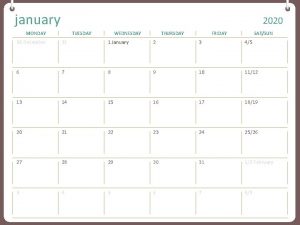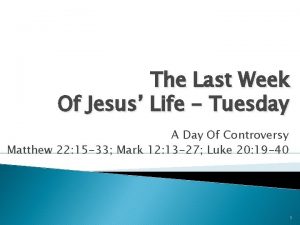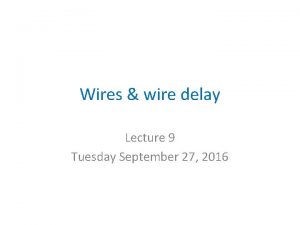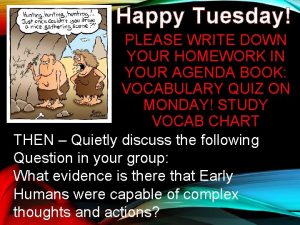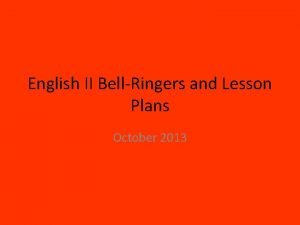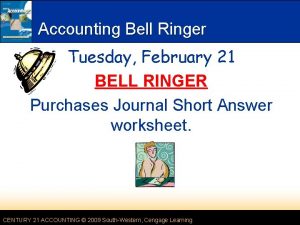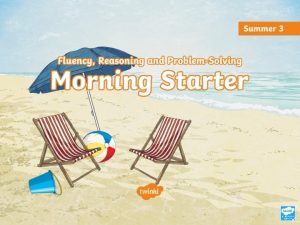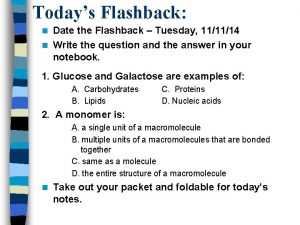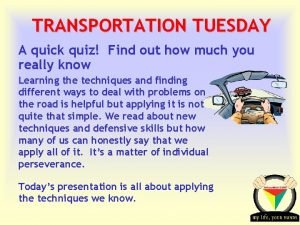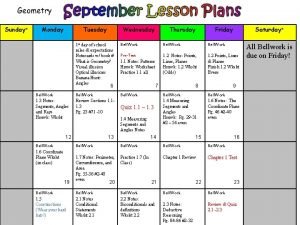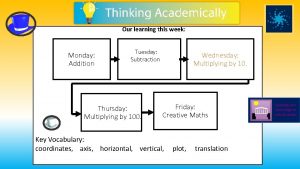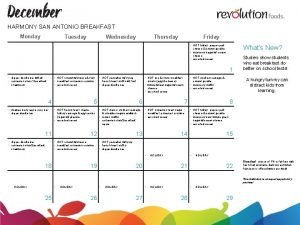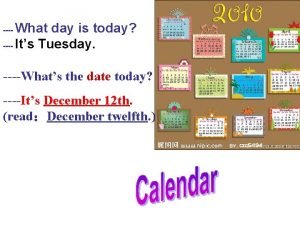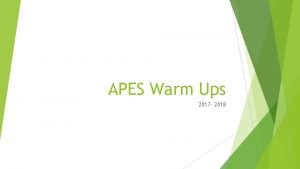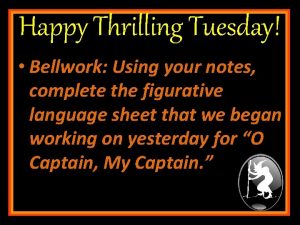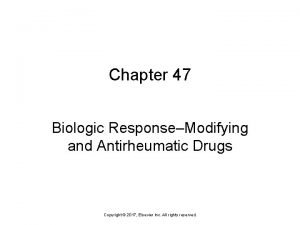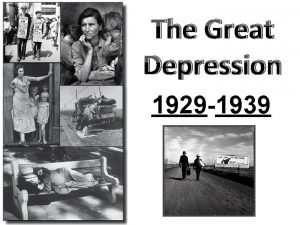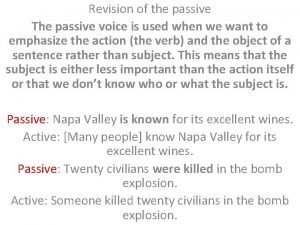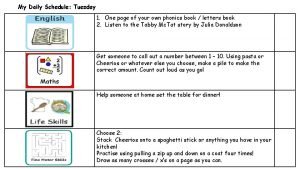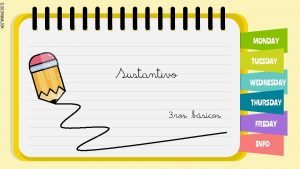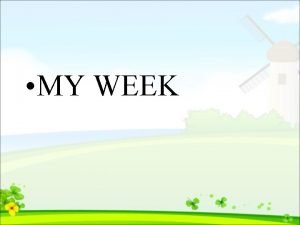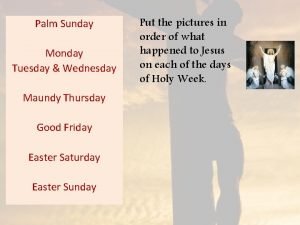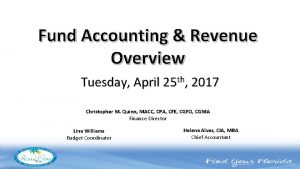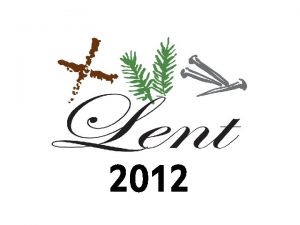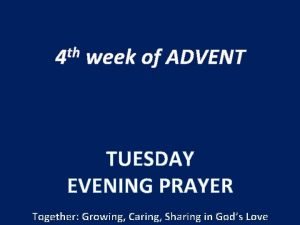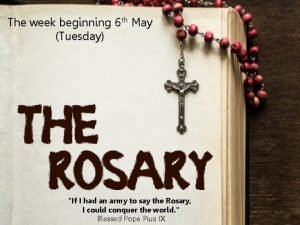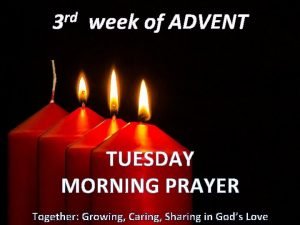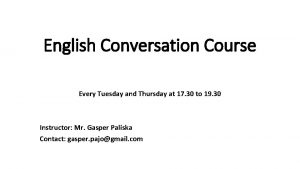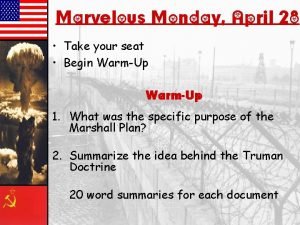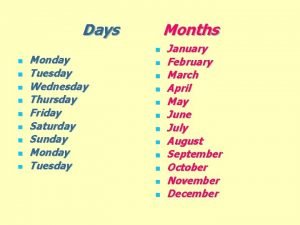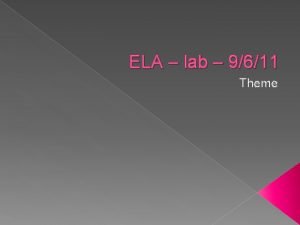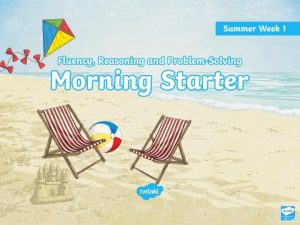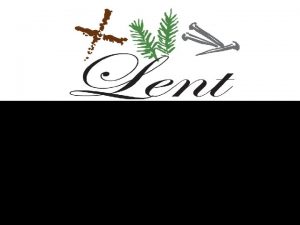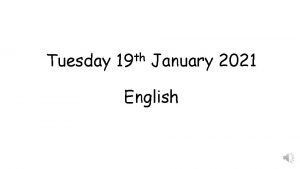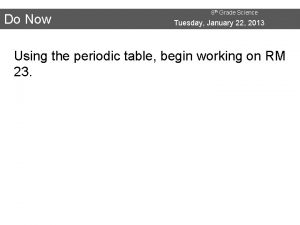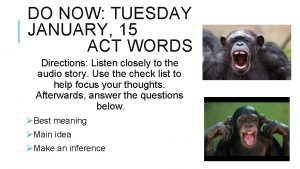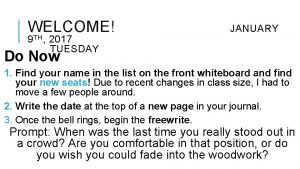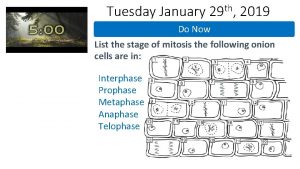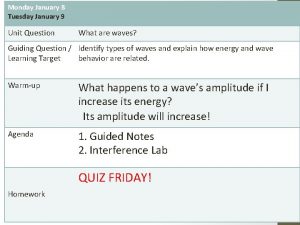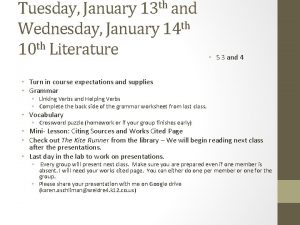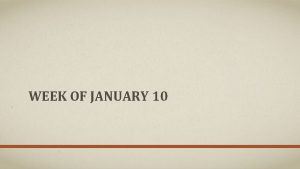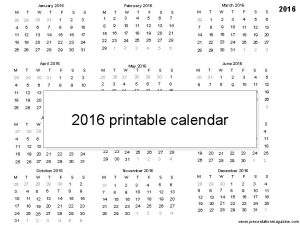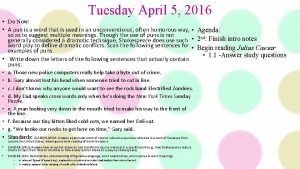Tuesday January 5 2016 Do Now What is




















































- Slides: 52

Tuesday January 5, 2016 › Do Now: What is your New Years goal for school? Write a paragraph explaining your goal and how you can achieve it. › Standards: ELAGSE 9 -10 W 4: Produce clear and coherent writing in which the development, organization, and style are appropriate to task, purpose, and audience. › ELAGSE 9 -10 W 3: Write narratives to develop real or imagined experiences or events using effective technique, well-chosen details, and well-structured event sequences. a. Engage and orient the reader by setting out a problem, situation, or observation, establishing one or multiple point(s) of view, and introducing a narrator and/or characters; create a smooth progression of experiences or events. › › › Agenda: Reminders Carpe Diem Ben’s Story Laws of Life Essay Introduction › Brainstorm Quote › Get your copy of To Kill a Mockingbird!

Laws of Life Introduction

Wednesday January 6, 2016 › Do Now: What is a narrative essay? What should it include? › Standards: ELAGSE 9 -10 W 4: Produce clear and coherent writing in which the development, organization, and style are appropriate to task, purpose, and audience. › ELAGSE 9 -10 W 3: Write narratives to develop real or imagined experiences or events using effective technique, wellchosen details, and well-structured event sequences. a. Engage and orient the reader by setting out a problem, situation, or observation, establishing one or multiple point(s) of view, and introducing a narrator and/or characters; create a smooth progression of experiences or events. › Agenda: › Quote Check › Narrative Essay review activity › Begin drafting Laws of Life Essay

Thursday January 7, 2016 › Do Now: Draw a hand on your paper (you will need room to write inside the hand). › Standards: ELAGSE 9 -10 W 4: Produce clear and coherent writing in which the development, organization, and style are appropriate to task, purpose, and audience. › ELAGSE 9 -10 W 3: Write narratives to develop real or imagined experiences or events using effective technique, wellchosen details, and well-structured event sequences. a. Engage and orient the reader by setting out a problem, situation, or observation, establishing one or multiple point(s) of view, and introducing a narrator and/or characters; create a smooth progression of experiences or events. › Agenda: › Write like a professional notes › Good ways to start your essay › Write your rough draft! Completed rough draft is due TOMORROW!

Checklist for Laws of Life Essay § Based on a personal experience § Contains details of the event – sights, sounds, tastes, touches, smells § Uses direct quotes of key characters’ comments § Includes a maxim § 500 words-700 words – at least 1 ½ - 2 pages typed, double-spaced § Cover sheet with your name -- Don’t put your name on the essay itself. 14

Friday January 8, 2016 › Do Now: Rough Draft Check and Highlighting › Agenda: › Standards: ELAGSE 9 -10 W 4: Produce clear and coherent writing in which the development, organization, and style are appropriate to task, purpose, and audience. › Peer Editing of Essay › ELAGSE 9 -10 W 3: Write narratives to develop real or imagined experiences or events using effective technique, wellchosen details, and well-structured event sequences. a. Engage and orient the reader by setting out a problem, situation, or observation, establishing one or multiple point(s) of view, and introducing a narrator and/or characters; create a smooth progression of experiences or events. › Rough Draft Check › Set up format for Laws of Life essay and begin typing

Monday January 11, 2016 › Do Now: MUG #12 › Agenda: › MUG #12 › Continue Typing Essay › Standards: ELAGSE 9 -10 W 4: Produce clear and coherent writing in which the development, organization, and style are appropriate to task, purpose, and audience. › ELAGSE 9 -10 W 3: Write narratives to develop real or imagined experiences or events using effective technique, well-chosen details, and well-structured event sequences. a. Engage and orient the reader by setting out a problem, situation, or observation, establishing one or multiple point(s) of view, and introducing a narrator and/or characters; create a smooth progression of experiences or events. › Get your copy of To Kill a Mockingbird for Wednesday!

Tuesday January 12, 2016 › Agenda: › Do Now: Find and write the definition for the following words: › Turnitin Submission information › Sycophant (noun) › Finish Typing Essay › Pernicious (adj. ) › Ubiquitous (adj. ) Standards: ELAGSE 9 -10 W 4: Produce clear and coherent › Essay due on Canvas by writing in which the development, organization, and style are appropriate to task, purpose, and audience. midnight WEDNESDAY › ELAGSE 9 -10 W 3: Write narratives to develop real or imagined experiences or events using effective › Get your copy of To Kill a technique, well-chosen details, and well-structured Mockingbird for event sequences. a. Engage and orient the reader by setting out a problem, situation, or observation, Wednesday! establishing one or multiple point(s) of view, and introducing a narrator and/or characters; create a smooth progression of experiences or events.




Wednesday January 13, 2016 › Agenda: › Do Now: What are the different › Turnitin Reminders types of narration/point-of› Unreliable Narrator Prezi view? › Standards: ELAGSE 9 -10 W 4: Produce clear and coherent writing in which the development, organization, and style are appropriate to task, purpose, and audience. › ELAGSE 9 -10 W 3: Write narratives to develop real or imagined experiences or events using effective technique, well-chosen details, and well-structured event sequences. a. Engage and orient the reader by setting out a problem, situation, or observation, establishing one or multiple point(s) of view, and introducing a narrator and/or characters; create a smooth progression of experiences or events. › Unreliable Narrator writing due tomorrow. › Essay due on Canvas by midnight WEDNESDAY › Get your copy of To Kill a Mockingbird for Wednesday!


Thursday January 14, 2016 › Agenda: › Do Now: Describe a time when you witnessed or experienced › Share your Villain's Diary entry- then turn it in. injustice because of age, gender, or ethnicity. What was › Background notes for To your reaction? What, if Kill a Mockingbird anything, could have been done to prevent the situation? 100 word count. › Get your copy of To Kill a › Standards: ELAGSE 9 -10 W 4: Produce clear and coherent Mockingbird for praise writing in which the development, organization, and style are appropriate to task, purpose, and audience. points. › ELAGSE 9 -10 RL 2: Determine a theme and/or central idea of text and closely analyze its development over the course of the text, including how it emerges and is shaped and refined by specific details; provide an objective summary of the text

Friday January 15, 2016 › Do Now: Find the definitions for the following words: – Non sequitur (noun) – Diatribe (noun) › Standards: ELAGSE 9 -10 W 4: Produce clear and coherent writing in which the development, organization, and style are appropriate to task, purpose, and audience. › ELAGSE 9 -10 RL 2: Determine a theme and/or central idea of text and closely analyze its development over the course of the text, including how it emerges and is shaped and refined by specific details; provide an objective summary of the text › Agenda: › Finish background notes for To Kill a Mockingbird › Chapter 1 Reading and Study Questions › Homework: Chapters 1, 2, and 3 by Tuesday › Get your copy of To Kill a Mockingbird for praise points.



To Kill a Mockingbird Chapter 1 Study Questions › 1. Our narrator is Scout, a girl who will grow from age 6 to almost 9 during the story. What do you suppose we, as the readers, should be aware of as we listen to Scout tell her story? Is a child a reliable or unreliable narrator? Defend your answer. › 2. Jem and Scout call their father by his first name, Atticus, instead of calling him “Dad” or “Daddy. ” What does this tell you about their relationship? › 3. We know that the setting of this story will be Maycomb, Alabama, a sleepy Southern town that’s a little rough around the edges. What is the time period of this story? Give evidence to support your conclusion about the time period of this novel. › 4. Dill, the children’s neighbor during the summer, is described as “a pocket Merlin, whose head teemed with eccentric plans, strange longings, and quaint fancies. ” What does this mean? › 5. Who are the Radleys? Describe their house and yard. › 6. Who were the Cunningham boys and what happened to them? What’s the irony here? › 7. According to Jem, how do you get a turtle to come out of its shell? In what way might this idea be an apt parallel to get people to do what they don’t want to do? Give an real-world example to support your answer. › 8. Find a simile from this chapter and write down the sentence in which it appears. Yes, I want you to write down the full sentence.

Chapter 2 Study Questions › 1. Why does Scout’s ability to read and write annoy her teacher, Miss Caroline? Record your answers on a separate sheet of paper. You must answer in complete sentences. › 2. Attitcus says that country people, like the Cunninghams, were hit the hardest by “the crash. ” To what is he referring? Why would country people be the ones to suffer the most? › 3. Why are professional people also suffering? › 4. Why does Jem not want Scout to acknowledge him at school? Is his behavior typical of an older brother? › 5. An entailment is an unusual legality that prohibits a piece of land from being sold. It was designed to protect a family’s interest in a piece of land because it could only be passed down to a member of the same family, never sold for profit. Jem describes an entailment as “a condition of having your tail in a crack, ” and Atticus later says that Jem’s description is surprisingly accurate. How is this an apt description for the Cunningham family? › 6. What do you think of Miss Caroline Fisher as a teacher?

Chapter 3 Study Questions › 1. Why does Walter Cunningham drench his lunch in molasses/syrup? › 2. When Scout criticizes Walter Cunningham’s eating habits, Calpurnia scolds Scout, smacks her on the bottom as she sends the girl out of the room, and then lectures her on proper manners, saying, “Yo’folks might be better’n the Cunninghams but it don’t count for nothin’ the way you’re disgracin’ ‘em. ” What does Calpurnia mean here? Is she right? › 3. In the tiff between Scout and Calpurnia, Atticus takes Calpurnia’s side. What does this show us? › 4. Describe the way that Atticus treats Walter. What do you think of this? › 5. Atticus tells Scout that you never really understand a person “until you climb into his skin and walk around in it. ” What does this mean? Give an example from your world to illustrate this idea. › 6. What is the “compromise” which Atticus suggests at the end of the chapter? › 7. Who are the Ewells? How are they the same as the Cunninghams? How are they different? › 8. Why do Maycomb officials bend the rules for the Ewells? Is this the right thing to do?

Tuesday January 19, 2016 › Do Now: › Agenda: › Reading Check Chapters 1 -3 › Discuss 1 -3 Readings › Standards: ELAGSE 9 -10 W 4: Produce clear and coherent writing in which the development, organization, and style are appropriate to task, purpose, and audience. › ELAGSE 9 -10 RL 2: Determine a theme and/or central idea of text and closely analyze its development over the course of the text, including how it emerges and is shaped and refined by specific details; provide an objective summary of the text › Chapter 4 Reading due tomorrow.

Chapter 4 Study Questions › 1. What does Scout think of her school’s new style of education? What does this failing show us about adults? › 2. What’s the first thing Scout finds in the knothole of the tree on the edge of the Radley property? What’s the second thing she finds? How many of each item was there? Significance of this? Who, do you suppose, put the items in the tree hole? › 3. Scout has two reasons for wanting to quit Jem and Dill’s Radley game. What are they?

Wednesday January 20, 2016 › Do Now: Define the words: › Slipshod (Adj. ) › Nefarious (Adj. ) › Standards: ELAGSE 9 -10 W 4: Produce clear and coherent writing in which the development, organization, and style are appropriate to task, purpose, and audience. › ELAGSE 9 -10 RL 2: Determine a theme and/or central idea of text and closely analyze its development over the course of the text, including how it emerges and is shaped and refined by specific details; provide an objective summary of the text › Agenda: › Chapter 4 Reading Check › Chapter 4 Discussion › Begin reading Chapter 5 › Homework: Chapters 5 -7 Reading Due tomorrow



Chapter 5 Study Questions › 1. Describe Miss Maudie Atkinson. How typical is she of Maycomb’s women? What do the children think of her? › 2. Miss Maudie says, “…sometimes the Bible in the hands of one man is worse than a whiskey bottle in the hand of—oh, of your father. ” Explain what she means. › 3. What does Miss Maudie tell Scout about Boo? How does this compare with what Scout already believes? › 4. Scout says that “Dill Harris could tell the biggest” lies she ever heard. Why might Dill have told such lies? › 5. Paraphrase Atticus’ speech about the Radleys’ right to privacy. Do you agree with his point of view? Why or why not?

Thursday January 21, 2016 › Agenda: › Do Now: What is identity? To what extent do we determine our › Chapter 6 & 7 Reading Check own identities? What influence does society have? › To Kill a Mockingbird Vocabulary Chart › Write 100 words › Standards: ELAGSE 9 -10 W 4: Produce clear and coherent writing in which the development, organization, and style are appropriate to task, purpose, and audience. › ELAGSE 9 -10 RL 2: Determine a theme and/or central idea of text and closely analyze its development over the course of the text, including how it emerges and is shaped and refined by specific details; provide an objective summary of the text › Vocabulary chart due tomorrow.

The Rosetta Stone › Ancient Egyptian hieroglyphs, Demotic script, and Greek script › Written in 196 BC › Helped translate Egyptian hieroglyphs.

Chapter 6 Study Questions › 1. List the four reasons Jem and Dill give for deciding to peek › into the Radley window on this particular night. › › 2. Find and write down the line from early in the chapter that foreshadows the trouble Jem will have when he tries to flee the Radley’s backyard. › › 3. Jem wants to return to the Radley yard and fetch his pants so he can stay out of trouble with Atticus. Scout wants Jem to leave the pants where they are and face the consequences with Atticus. With which child do you agree? Why?

Chapter 7 Study Questions › 1. According to Scout, what’s the only good thing about second grade? › 2. What spooked Jem on the night of the Radley house incident? Who, do you suppose, did this? › 3. After they find the soap dolls, what does Jem realize that Scout does not yet understand? › 4. Look closely at this line: “Jem stared at me so long I asked what was the matter, but got Nothing, Scout for an answer. ” What does the elimination of the quotation punctuation do for this passage? › 5. At the end of the chapter, Jem quietly cries alone on the porch.

Friday January 22, 2016 › Do Now: Define the following words: › Precursor › Impregnable › Demure › Standards: ELAGSE 9 -10 W 4: Produce clear and coherent writing in which the development, organization, and style are appropriate to task, purpose, and audience. › ELAGSE 9 -10 RL 2: Determine a theme and/or central idea of text and closely analyze its development over the course of the text, including how it emerges and is shaped and refined by specific details; provide an objective summary of the text › Agenda: › Turn in Vocabulary Web › In-class reading of Chapter 8 › Laws of Life Essay submission › Chapters 8 -10 Reading due Monday › Work on study questions found online




Chapter 8 Study Questions › 1. What does Mr. Avery say that bad children cause? What’s ironic about this, given Jem and Scout’s reaction to the snow? › 2. Why does Atticus awaken Jem and Scout instead of just letting them sleep through the fire incident? Give a line of text to support your answer. › 3. During the fire, Boo Radley has quietly placed a blanket across Scout’s shoulders. Why doesn’t Jem want his father to return the blanket to the Radley family? › 4. After the fire is over, how does Miss Maudie feel about the destruction of her house? What does this tell you about her character, her values? › 5. Write down the line of text from this chapter that shows Jem believes that he and Scout are no better than anyone else in their town. › 6. Once you’ve finished the chapter, go back and look at the portion that describes Jem and Scout’s snowman, which is covered with white snow on the outside, but has a core of dark mud. Symbolically connect the snowman to either Mr. Avery (go beyond the “Morphodite’s” physical similarity to Mr. Avery) or Boo Radley. How could the snowman be seen as a symbol for one of these men?

Monday January 25, 2016 › Do Now: MUG #14 › Agenda: › Chapter 8 -10 Reading Check › Vocabulary Around-theroom › Standards: ELAGSE 9 -10 W 4: Produce clear and coherent writing in which the development, organization, and style are appropriate to task, purpose, and audience. › ELAGSE 9 -10 RL 2: Determine a theme and/or central idea of text and closely analyze its development over the course of the text, including how it emerges and is shaped and refined by specific details; provide an objective summary of the text › Chapter 11 Reading due tomorrow. › Laws of Life Essay submission reminder

To Kill a Mockingbird Vocabulary 1. Predilection 2. Taciturn 3. Amble 4. Entailment 5. Truant 6. Cordiality 7. Benign 8. Auspicious 9. Unfathomable 10. Inquisitive 11. Assuaged 12. Indigenous 13. Persevere 14. Melancholy 15. Perpetual 16. Perplexity 17. Induce 18. Deportment 19. Articulate 20. Erratically 21. Apothecary 22. Malevolent 23. Vexations 24. Smilax 25. Sojourn 26. Disapprobation 27. Quelling 28. Evasion 29. Asinine 30. Phenomena 31. Benevolence 32. Edification 33. Inordinately 34. Obstreperous 35. Cantankerous

Tuesday January 26, 2016 › Agenda: › Do Now: Go ahead and finish your vocabulary chart. You have › Chapter 11 Reading Check 10 minutes! › Character Found Poetry project- Due Thursday › Standards: ELAGSE 9 -10 W 4: Produce clear and coherent writing in which the development, organization, and style are appropriate to task, purpose, and audience. › ELAGSE 9 -10 RL 2: Determine a theme and/or central idea of text and closely analyze its development over the course of the text, including how it emerges and is shaped and refined by specific details; provide an objective summary of the text › Laws of Life Essay submission reminder- Due tomorrow for bonus points! › Earn 50 points by going to the play! (Receipt, ticket stub, or program must be submitted to earn credit)

Wednesday January 27, 2016 › Do Now: Define the terms below: › Jingoistic › Implacable › Affinity › Standards: ELAGSE 9 -10 W 4: Produce clear and coherent writing in which the development, organization, and style are appropriate to task, purpose, and audience. › ELAGSE 9 -10 RL 2: Determine a theme and/or central idea of text and closely analyze its development over the course of the text, including how it emerges and is shaped and refined by specific details; provide an objective summary of the text › Agenda: › Character Found Poetry project- Due tomorrow! › Laws of Life Essay submission- Due today for bonus points




Thursday January 28, 2016 › Do Now: Copy the terms below: › Agenda: › Turn in character Found Poetry project › Chapter 8 -11 discussion › Begin reading Chapters 12 -15 DUE MONDAY – Finish study questions to use for reading check › Standards: ELAGSE 9 -10 W 4: Produce clear and coherent writing in which the development, organization, and style are appropriate to task, purpose, and audience. › ELAGSE 9 -10 RL 2: Determine a theme and/or central idea of text and closely analyze its development over the course of the text, including how it emerges and is shaped and refined by specific details; provide an objective summary of the text › SAT Do Now word quiz next Wednesday. Memorize definition AND spelling

Chapter 8 Reading Questions › 1. What does Mr. Avery say that bad children cause? What’s ironic about this, given Jem and Scout’s reaction to the snow? › 2. Why does Atticus awaken Jem and Scout instead of just letting them sleep through the fire incident? Give a line of text to support your answer. › 3. During the fire, Boo Radley has quietly placed a blanket across Scout’s shoulders. Why doesn’t Jem want his father to return the blanket to the Radley family? › 4. After the fire is over, how does Miss Maudie feel about the destruction of her house? What does this tell you about her character, her values? › 5. Write down the line of text from this chapter that shows Jem believes that he and Scout are no better than anyone else in their town. › 6. Once you’ve finished the chapter, go back and look at the portion that describes Jem and Scout’s snowman, which is covered with white snow on the outside, but has a core of dark mud. Symbolically connect

Chapter 9 Reading Questions › 1. When Atticus speaks of defending Tom Robinson, he says, “Simply because we were licked a hundred years before we started is no reason for us not to try to win. ” To what is Atticus referring? Why would it be worthwhile to fight a battle that you know you’re going to lose? › 2. Think about Scout’s fight with Francis and Atticus’ message to Uncle Jack about children being able to “spot an evasion quicker than adults. ” How do these two elements connect to the value of having Scout, a child, be the narrator of this story? › 3. Atticus is worried about “ugly things” that the family will face in the next few months. Although we haven’t read this part of the story yet, what sorts of things do you suppose have Atticus worried? › 4. Thinking back to earlier chapters, what do we know about the Ewells? From this chapter, what do we know about Tom Robinson? Given this, why would the townsfolk be more likely to accept Mr. Ewell’s testimony than Mr. Robinson’s? › 5. According to Atticus, what is Maycomb’s “usual disease? ” Why is he worried that his children will catch it? › 6. Read the final sentence of this chapter. Explain in your own words what

Chapter 10 Study Questions 1. Record the line of text that includes the reference to the title. Explain its meaning in the scene and take a guess as to the idea’s larger meaning. I know you haven’t finished the book yet, but I still want you to guess about how this line connects to the message of the novel. › 2. At the beginning of the chapter, Scout is critical of Atticus because he seems old and doesn’t do anything that she deems impressive. By the end of the chapter, her opinion has changed. Why? › 3. Why isn’t Atticus proud of his shooting ability? › 4. What is Miss Stephanie Crawford’s reaction to the death of Tim Johnson?

Chapter 11 Study Questions › 1. When Mrs. Henry Lafayette Dubose pushes Jem too far, he loses his mind a bit, destroying her flowers and breaking Scout’s baton. What other rough thing does he do in that moment? What message can we take from this part of the incident? › 2. What was Jem’s punishment? Did it fit his crime? › 3. Atticus is not upset that Mrs. Dubose calls him foul names behind his back. To Scout, he explains, “. . . it’s never an insult to be called what somebody thinks is a bad name. It just shows you how poor that person is, it doesn’t hurt you. ” Explain his meaning. Do you agree or disagree with him? Why? Finally, give a real-world example from your life to illustrate your point. › 4. Why does Mrs. Dubose keep the children a few minutes longer each day? › 5. In what ways was Mrs. Dubose heroic? › 6. Other than living on the same street, what do Boo Radley, Atticus, and Mrs. Dubose all have in common? What larger message is supported by examination of these three characters? › 7. Look back over this chapter and record two similes. Yes, I want

Friday January 29, 2016 › Do Now: Write about the meaning of COURAGE. Give examples of courageous behavior. Which kinds (or examples) of courage seem to be most admirable? › Standards: ELAGSE 9 -10 W 4: Produce clear and coherent writing in which the development, organization, and style are appropriate to task, purpose, and audience. › ELAGSE 9 -10 RL 2: Determine a theme and/or central idea of text and closely analyze its development over the course of the text, including how it emerges and is shaped and refined by specific details; provide an objective summary of the text › Agenda: › Close Reading Activity › In-class reading › SAT Vocabulary Quiz next Wednesday: Study definitions and spelling › Continue reading Chapters 12 -15 DUE MONDAY – Finish study questions to use for reading check

Study Questions Chapter 12 › 1. Why do Jem and Scout go to church with Calpurnia? Where is Atticus? › 2. Why is the church named First Purchase? › 3. Does Lula speak for the majority opinion in the congregation? Why does the author include her in the church scene? › 4. What is the crime that’s been charged against Tom Robinson? › 5. Why can’t Helen Robinson work and support her three children? › 6. During the church service, we find out that Calpurnia is one of the few African-American residents of Maycomb who can read. The children get to know Cal better during this Sunday and realize lots of things about her that they didn’t know, including that she’s older than they realized. Look closely at this passage: “But, Cal, ” Jem protested, “you don’t look even near as old as Atticus. ” “Colored folks don’t show their ages so fast, ” she said. “Maybe because they can’t read. . . ” What’s humorous or interesting about this short passage? › 7. What nasty surprise awaits the children at the very end of the chapter?

Study Questions Chapter 13 › 1. Scout and Aunt Alexandra communicate very poorly with each other. Is the fault more with one than the other, or are they equally at fault? Explain your answer. › 2. What’s the reason the children are given as to why Aunt Alexandra has come to stay with them? What do you think is the real reason? › 3. Atticus says to Scout, “Your aunt’s doing me a favor as well as you all. I can’t stay here all day with you, and the summer’s going to be a hot one. ” There’s a double-meaning to this line. Explain. › 4. Aunt Alexandra is critical of many of Maycomb’s families. According to Jem, what’s ironic about this? › 5. What did Cousin Joshua do and how does he become a wedge between Aunt Alexandra and Atticus? › 6. Look at the last short paragraph of the chapter. What was Atticus trying to do? Why is this sort of thing, according to Scout, better left to a woman?

Study Questions Chapter 14 › 1. How does Aunt Alexandra feel about Calpurnia? Explain why this is “in character” for Aunt Alexandra? › 2. Comment on Atticus’ explanation of rape. Why does Atticus explain the crime in this way? › 3. What does Jem do that, to Scout, symbolizes the end of his childhood? › 4. Dill tries to explain to Scout why he did not want to stay with his mother and new stepfather. State his reasons briefly in your own words. › 5. Twice now, Scout has considered running away. Dill did, in fact, run away from home. Why, according to Dill, hasn’t Boo Radley ever run away from his terrible home?

Study Questions Chapter 15 › 1. What was the “sickening comic aspect” of Atticus’ exchange with the small mob of men? What does this show us about the men in the small mob? About Atticus? › 2. Why does Jem openly defy Atticus and refuse to leave? › 3. What does Scout’s childish attempt at conversation accomplish? Explain. › 4. Why was Atticus so affectionate toward Jem, even after Jem disobeyed him?
 Sunday, tuesday, january, saturday
Sunday, tuesday, january, saturday January 2006 chemistry regents answers
January 2006 chemistry regents answers Now i see it now you don't
Now i see it now you don't Tuesday lobsang rampa
Tuesday lobsang rampa The last week of jesus life
The last week of jesus life Distributed rc delay model
Distributed rc delay model Tuesday homework
Tuesday homework Tuesday morning prayer
Tuesday morning prayer Tuesday bellringer
Tuesday bellringer My friend jose will travel here on tuesday
My friend jose will travel here on tuesday Petty cash report cengage
Petty cash report cengage Monday=621 tuesday=732 wednesday=933
Monday=621 tuesday=732 wednesday=933 Flashback tuesday
Flashback tuesday Stock market crash 1942
Stock market crash 1942 Shrove tuesday quiz
Shrove tuesday quiz Wednesday bellwork
Wednesday bellwork At what college did morrie and mitch first meet?
At what college did morrie and mitch first meet? On monday and tuesday
On monday and tuesday Breakfast tuesday
Breakfast tuesday Working tuesday
Working tuesday Is today tuesday
Is today tuesday Tuesday warm up questions
Tuesday warm up questions Tuesday bellwork
Tuesday bellwork Tuesday blessings
Tuesday blessings On a tuesday
On a tuesday Due tuesday
Due tuesday Tuesday evening prayer
Tuesday evening prayer Black tuesday great depression
Black tuesday great depression I lent a pencil to graham
I lent a pencil to graham My daily schedule
My daily schedule Slidesmania
Slidesmania Tuesday morning prayers
Tuesday morning prayers Monday tuesday wednesday saturday
Monday tuesday wednesday saturday Tuesday's class
Tuesday's class Tuesday-sunday
Tuesday-sunday Good morning stay at home
Good morning stay at home Enduring word matthew 13
Enduring word matthew 13 How did you ... your last weekend?
How did you ... your last weekend? Enum days sunday monday=5 tuesday=6 wednesday=7
Enum days sunday monday=5 tuesday=6 wednesday=7 Monday tuesday wednesday thursday friday calendar
Monday tuesday wednesday thursday friday calendar Accept the past as past without denying it or discarding it
Accept the past as past without denying it or discarding it Overview tuesday
Overview tuesday Pancake tuesday 2012
Pancake tuesday 2012 Tuesday evening prayer
Tuesday evening prayer Tuesday at 6
Tuesday at 6 Tuesday morning prayer for family and friends
Tuesday morning prayer for family and friends Sentences from before
Sentences from before Marvelous monday terrific tuesday wonderful wednesday
Marvelous monday terrific tuesday wonderful wednesday Shrove tuesday significato
Shrove tuesday significato Monday tuesday wednesday thursday friday saturday sunday
Monday tuesday wednesday thursday friday saturday sunday Tuesday theme ideas
Tuesday theme ideas 1
1 Tuesday evening prayer
Tuesday evening prayer
